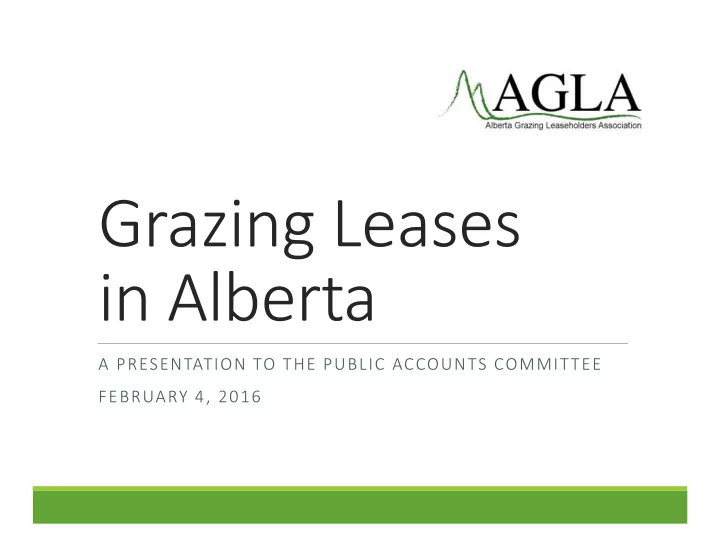

A PRESENTATION TO THE PUBLIC ACCOUNTS COMMITTEE FEBRUARY 4, 2016
Grazing Leases Overview • First instituted in Alberta in 1881 • Crown land designated for agricultural use • 5,700 leases ... 5.3 million acres (2.1M Ha) � Average lease about 1 section (1 sq. mile/2.6 km 2 ) � Supports about 50 cows • Leaseholders pay rent to GoA based on what the land can accommodate and agricultural use • Leaseholders manage many competing interests on the land base
Grazing Leases Overview • Roughly 20% of Alberta’s cowherd is dependent on grazing leases for their forage requirements. • Grazing leases, coupled with deeded holdings, form an integral part of a farm or ranch unit. • Grazing leases provide the additional capacity to feed approximately 1 million head of animals. • These animals supply our meat product manufacturing industry which accounted for over half of Alberta's food manufacturing of $12.7 billion in 2014.
Grazing leases offer an ecological benefit • Rangelands have developed under a regime of historical grazing by buffalo and fire. • Albertans benefit by having leaseholders manage the replacement tool for these grasslands -- cattle. • Leaseholders ensure the long-term sustainability of the land and watershed as well as protect animals and plants at risk. • Alberta’s grazing lease system has implemented a knowledge-based approach that allows those closest to the land to be the day-to-day stewards.
Leaseholders are Land Stewards • In Alberta grazing lease management is governed through public policy goals, updated legislation, and regulatory decision making. • Grazing lease holders must ensure the health of the entire grazing ecosystem. This includes soils, grazing animals, plants, minerals, nutrients and water. • Leaseholders must meet performance measures in the Code of Practice (EAP) and through range health assessment systems.
Improvements by Leaseholders • Stewardship has costs: � Monitor vegetation to ensure survival � Fencing, developing and managing water and building livestock handling infrastructure • Holistic stewardship is impacted by surface developments by energy operations. • Surface Rights Act requires compensation for loss of use, adverse effects, nuisance and other damages (on both private and Crown lands).
Wellsite Compensation • Compensation is not: • “Rent” • “Revenue” • “Payment for Access” • Compensation is “compensation”: • Payment for losses and impacts rancher’s experience when oil & gas wells drilled • Surface Rights Act requires that leaseholders be made “whole” • Payable by the energy company to the party directly affected – the leaseholder
Compensation Misunderstood • Auditor General and Alberta Land Institute reports have suggested this compensation should go to province instead of the leaseholder – but Crown is not the directly affected party. • It is the rancher who is directly affected by gates left open, dust, noise, loss of use, or the costs of moving cattle. • Why should this compensation go to the government that does not suffer these losses or costs?
Transparent Process • Surface Rights Act, section 25 requires compensation for loss of use, adverse effects, nuisance and inconvenience • Crown leaseholders have the same rights as lessees of private lands – no special rights for Crown leaseholders • Surface Rights Board sets compensation rates when parties can’t reach voluntary agreement. Public hearing and public decisions released on Board’s website. • Board’s decision are reviewable by Queen’s Bench • Follows a clear, transparent legal process
Crown has other revenue tools • If the Crown requires additional revenue to meet public policy objectives, the government could increase: � mineral lease bonus payments; � annual mineral lease rental payments; � royalty rate increases on production; as well as � other related taxes on the energy industry . • It makes little sense to remove the current compensation model which is designed to ensure the “leaseholder is not made worse off.”
Working Together • AGLA members have and will continue to work with GoA on improving the future state for grazing • Developing policies that address economic, environment, geographic and stewardship objectives • Will contribute to Environment and Parks updating: • Rental framework • Assignment fees • Range Stewardship Fund
For more Information please contact: Larry Sears Chairman, AGLA 403-625-0417 larrylsears@gmail.com Or visit our website at: http://www.albertagrazinglease.ca/
Recommend
More recommend